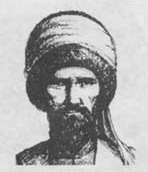Ghazi Muhammad
| Qazi Muhammad | |
|---|---|
 | |
| Imam of Dagestan | |
| Reign | 1829 - 1832 |
| Successor | Gamzat-bek |
| Born |
1793? Gimry |
| Died |
1832 (aged 38–39) Gimry, Dagestan |
| Burial | Tarki, Dagestan |
| Religion | Muslim, Sufi |
Qazi Mullah (Russian: Кази-Мулла, Kazi-Mulla, early 1790s[1]–1832) was an Islamic scholar and ascetic, who was the first Imam of the Caucasian Imamate (from 1828 to 1832). He was a staunch ally of Imam Shamil.[2] He promoted Sharia, spiritual purification, and facilitated a jihad against the invading Russians. He was also one of the prime supporters of "Muridism", a strict obedience to Koranic laws used by imams to increase religio-patriotic fervor in the Caucasus.[3]
Early life
He was a close friend of Imam Shamil during his childhood in Dagestan. They both studied the Koran and Sufism together at Yaraghal, a Murid centre, and both disliked the loose customs of the mountain people that contradicted the laws in Koran.[4] His mentor was Mullah Mohammed Yaraghi, a Naqshbandi Sufi scholar that brought the Mullah into the ulema.[5]
He preached that Jihad would not occur until the Caucasians followed Sharia completely rather than following a mixture of Islamic laws and adat (customary traditions). By 1828, Mullah began proselytizing and claiming that obeying Sharia, giving zakat, prayer, and hajj would not be accepted by Allah if the Russians were still present in the area. He even went on to claim that marriages would become void and children bastards if any Russians were still in the Caucasus.[5]
Qazi Mullah became one of the most prominent preachers of Islam in the Caucasus. His memorization of over four hundred ahadith allowed him to win many debates against rival preachers in the area. As his reputation grew, he was invited by many khanates and kingdoms loyal, indifferent, and hostile to the Czar.[6] As a sign of humility and austerity, he refused to ride, but would walk.
Holy war
(For military details see Murid War.) Later that year he was proclaimed imam in Ghimry, where he formally made the call for a holy war.[5] He also decreed that all wine should be destroyed publicly. In 1830, Qazi Mullah and Shamil unsuccessfully tried to capture the Avar capital of Khunzakh from the khanum Pakkou-Bekkhe. Following the setback, Shamil prevailed upon him to bide his time for a while, until all the tribes became united in following shariat law. In 1831, after a few months of quiet, he attacked Northern Dagestan, and met with success there.[7] His guerilla tactics caught the Russians unprepared. By 1832 he was able to menace Vladikavkaz, however, the Russians repulsed the Mullah's assault, and when they took Ghimry, according to legend, they found
| “ | Qazi Mullah dead but seated, legs folded on his prayer carpet, one hand on his beard, and the other pointing toward the sky[5] | ” |
The Russians took his body to Tarku and gave it to the Khan, who had been loyal to them. The body was displayed in the marketplace for a few days, before being buried in the hills.
Song
A posthumous song was composed for him, Хьэтхым и къуэ к1асым Мыхьэмэт и уэрэд,
Song for Qazi Mohamed.
References
- The Russian empire: historical and descriptive.John Geddie. Oxford University, 1882
- Caucasus Mountain Men and Holy Wars. Nicholas Griffin. Thomas Dunne Books, 2003. ISBN 0-312-30853-1
- The Shade of Swords: Jihad and the Conflict Between Islam and Christianity. Akbar, M.J. Routledge, 2003. ISBN 0-415-32814-4
- The Sabres of paradise Lesley Blanch. Carroll & Graf, 1984. ISBN 0-88184-042-4
- Kaziev, Shapi. Imam Shamil. "Molodaya Gvardiya" publishers. Moscow, 2001, 2003, 2006, 2010
Notes
- ↑ Gammer, Chapter 6, note 1 says that the sources give various dates. All that can be established is that he was a few years older than Shamil which points to the early 1790s. Baddeley gives 1793
- ↑ Daghestan - Worldstatesmen.org
- ↑ Geddie 386
- ↑ Griffin 32
- 1 2 3 4 Akbar 151
- ↑ Griffin 45
- ↑ Muslim Resistance to the Tsar. Shamil and the Conquest of Chechnia and Daghestan - International Journal of Middle East Studies